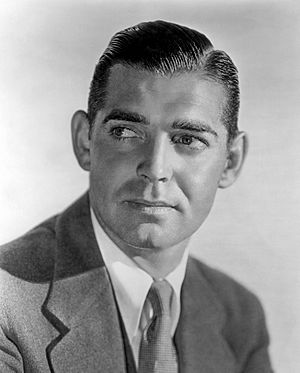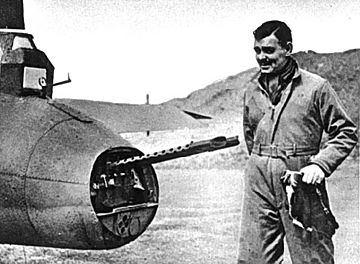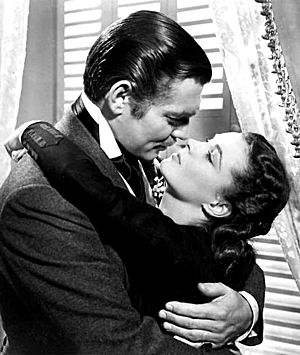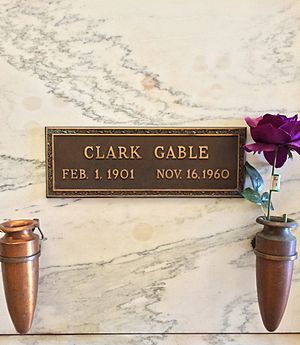Clark Gable facts for kids
Quick facts for kids
Clark Gable
|
|
|---|---|

Studio publicity photo
|
|
| Born |
William Clark Gable
February 1, 1901 |
| Died | November 16, 1960 (aged 59) |
| Cause of death | coronary thrombosis |
| Resting place | Forest Lawn Memorial Park, Glendale, California |
| Other names | The King (of Hollywood) |
| Occupation | Actor |
| Years active | 1923–1960 |
| Spouse(s) | Josephine Dillon (m. 1924–1930; divorced) Maria "Ria" Franklin Prentiss Lucas Langham (m. 1931–1939; divorced) Carole Lombard (m. 1939–1942; her death) Sylvia Ashley (m. 1949–1952; divorced) Kay Williams (m. 1955–1960; his death) |
| Children | Judy Lewis, John Gable |
| Signature | |
William Clark Gable (born February 1, 1901 – died November 16, 1960) was a famous American actor. Many people called him "The King of Hollywood" or just "The King."
Gable started his career on stage. He appeared as an extra in silent movies from 1924 to 1926. Later, he got supporting roles in films for Metro-Goldwyn-Mayer in 1931. The next year, he landed his first main role in Hollywood. Over the next 30 years, he became a leading man in more than 60 movies.
On February 8, 1960, Clark Gable received a star on the Hollywood Walk of Fame. This honor was for his work in movies. His star is located at 1608 Vine Street.
Contents
Clark Gable's Acting Career
Clark Gable won an Academy Award for Best Actor for his role in It Happened One Night (1934). He was also nominated for his leading roles in Mutiny on the Bounty (1935). His most famous role was likely Rhett Butler in the big Civil War movie Gone with the Wind (1939).
Gable also had great success with other films. These include Red Dust (1932) and Manhattan Melodrama (1934). Other popular movies were San Francisco (1936) and Saratoga (1937). He also starred in Boom Town (1940) and The Hucksters (1947). His last movie was The Misfits (1961).
Working with Other Stars
Clark Gable acted alongside many popular actresses. Joan Crawford was his favorite actress to work with. They made eight films together. Myrna Loy worked with him seven times. He also starred with Jean Harlow in six movies.
Gable appeared with Lana Turner in four films. He also worked with Norma Shearer and Ava Gardner three times each. His final film, The Misfits (1961), was also the last movie for Marilyn Monroe.
Clark Gable was one of the most successful actors at the box office. He appeared on the Top Ten Money Making Stars Poll 16 times. The American Film Institute named him the seventh-greatest male star of classic American cinema.
Early Training
Clark Gable's acting coach was Josephine Dillon. She was a theater manager and 17 years older than him. She helped him improve his looks and acting skills. She paid for his teeth to be fixed and his hair to be styled.
Dillon also helped him build up his body. She taught him how to control his body and have better posture. She spent a lot of time training his voice. He learned to lower his naturally high-pitched voice. This helped him sound more natural and convincing. After much training, Dillon felt he was ready for a film career.
Gone with the Wind Role
Clark Gable is most famous for his role in Gone with the Wind (1939). He played Rhett Butler. Even though he didn't really want the role, he earned an Oscar nomination for Best Actor.
Rhett Butler's last line in the movie is very famous. He says, "Frankly, my dear, I don't give a damn." This line is one of the most well-known in movie history.
Clark Gable's Military Service
In 1942, Clark Gable joined the U.S. Army Air Forces. The movie studio, MGM, did not want him to go. But Gable decided to join. General Henry H. "Hap" Arnold offered Gable a special job in aerial gunnery.
Gable enlisted on August 12, 1942. He wanted to become an aerial gunner on a bomber. MGM arranged for his friend, cinematographer Andrew McIntyre, to join with him. They went through training together.
Gable spent most of 1943 in England. He was with the 351st Bomb Group. He flew five combat missions as an observer-gunner. These missions were in B-17 Flying Fortress planes. He flew one mission to Germany. For his bravery, he earned the Air Medal and the Distinguished Flying Cross.

In May 1944, Gable was promoted to major. He wanted to go on more combat missions. But he was too old for combat. So, he was released from active duty on June 12, 1944. His discharge papers were signed by Captain Ronald Reagan, who later became a U.S. President.
It is said that Adolf Hitler admired Clark Gable. During World War II, Hitler reportedly offered a reward to anyone who could capture Gable unharmed.
Gable received several military awards. These included the Distinguished Flying Cross and the Air Medal. He also received the American Campaign Medal, the European-African-Middle Eastern Campaign Medal, and the World War II Victory Medal. He also earned his aerial gunner wings.
He used his wartime experiences in the movie Command Decision (1948). In this film, he played a World War II general who oversaw bombing raids.
Clark Gable's Later Life and Death
On November 6, 1960, Clark Gable was taken to a hospital in Los Angeles. Doctors found he had suffered a heart attack. News reports said he was in stable condition. He seemed to be getting better on November 16. However, he died that evening at age 59. The cause was an arterial blood clot.
Clark Gable is buried at Glendale's Forest Lawn Memorial Park. He rests next to his third wife, Carole Lombard. His fifth wife, Kay Williams Gable, is also buried there.
Clark Gable's Filmography
Clark Gable appeared as an extra in 13 films between 1924 and 1930. After that, he starred in 67 movies released in theaters. He also appeared as himself in 17 short films. He narrated a World War II propaganda film called Combat America. This film was made by the United States Army Air Forces.
Clark Gable in Popular Culture
In the movie Broadway Melody of 1938, a 15-year-old Judy Garland sings "You Made Me Love You." She sings it while looking at a picture of Clark Gable. The song starts with: "Dear Mr. Gable, I am writing this to you, and I hope that you will read it so you'll know, my heart beats like a hammer, and I stutter and I stammer, every time I see you at the picture show..."
The way Bugs Bunny casually chews carrots comes from a scene in It Happened One Night. In that movie, Clark Gable's character leans against a fence. He eats carrots quickly and talks with his mouth full to Claudette Colbert's character.
Images for kids
-
In 1928's Machinal with Zita Johann, Gable was praised as "young, vigorous, and brutally masculine" by one critic.
-
James Stewart and Gable, 1943
-
Lionel Barrymore's 61st birthday in 1939, standing: Mickey Rooney, Robert Montgomery, Clark Gable, Louis B. Mayer, William Powell, Robert Taylor, seated: Norma Shearer, Lionel Barrymore, and Rosalind Russell
-
Gable and Yvonne De Carlo in Band of Angels (1957)
-
Gable, Cary Grant, Bob Hope and David Niven laughing in the 1950s
See also
 In Spanish: Clark Gable para niños
In Spanish: Clark Gable para niños






















